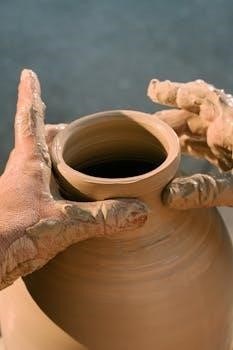Lippert slide-out systems are common in RVs, and understanding their manual override is crucial. This procedure allows you to operate your slide-out in case of power or motor failure, ensuring functionality.
Understanding the Need for Manual Override
The necessity for a manual override in Lippert slide-out systems arises from the potential for electrical or mechanical failures that can render the automatic system inoperable. These failures may stem from power outages, motor malfunctions, or controller issues. In such situations, the manual override provides a crucial backup, enabling you to extend or retract the slide-out room. This is essential for accessing or securing your RV, especially in emergencies or when regular operational methods are not available. Understanding and being prepared to use this manual override can prevent significant inconveniences, ensuring you maintain control over your RV’s slide-out functionality, regardless of system failures. Knowing the manual override procedure allows you to avoid getting stuck in a difficult situation.
Types of Lippert Slide-Out Systems
Lippert offers both electric and hydraulic slide-out systems. Each type has a distinct manual override method, requiring different tools and procedures to operate if needed.
Electric Slide-Out Systems
Electric Lippert slide-out systems utilize a motor to extend and retract the room using a drive shaft. These systems often feature a built-in automatic braking mechanism. The manual override for electric systems typically involves a crank extension found on the motor’s end, usually accessible from outside the RV’s chassis. A crank handle connects to this extension, allowing manual operation. The system is designed for both positive and negative ground operation. Understanding the location of this extension is crucial for utilizing the manual override correctly. Always be sure to check the specific location of the crank extension for your model, as it can vary.
Hydraulic Slide-Out Systems
Lippert hydraulic slide-out systems employ a hydraulic cylinder to move the room. A power unit drives the cylinder rod to extend and retract the slide. These systems are designed to operate as a negative ground. The manual override for hydraulic systems typically involves using an auxiliary power device, such as a standard electric or cordless drill. This device is used to power the system in place of the main electrical system, allowing for the manual extension or retraction of the room. A standard 3/8” drill is commonly used for this procedure, making it accessible for most users. The process enables operation during electrical failures.
Locating the Manual Override Mechanism
The manual override mechanism on Lippert electric slides often involves a crank extension located outside the chassis rail. This is where a crank handle connects for manual operation.
Identifying the Crank Extension
The crank extension is a key component for manual operation of Lippert electric slide-outs. Typically, you’ll find it positioned outside the main chassis rail, often underneath the unit. It’s designed as a point of connection for the manual crank handle. This extension allows you to bypass the electric motor and physically move the slide room. The location can vary, sometimes being found under the end of the motor. It is important to locate this extension before attempting manual override procedures. Some models may have the extension located inside the frame, requiring different access.

Manual Override Procedure for Electric Systems
For electric slide-outs, a manual crank handle is used. This handle engages with the crank extension, allowing you to manually move the slide room in or out.
Using the Crank Handle
To manually operate an electric Lippert slide-out, locate the crank extension, typically found outside the chassis rail or sometimes under the frame. Attach the provided crank handle to this extension. Begin turning the handle in the appropriate direction, either clockwise to retract or counter-clockwise to extend the slide-out room. It’s important to note that this process may require some physical effort. Maintain a steady turning motion and avoid abrupt movements. Be aware that the slide-out room may move slowly compared to electrical operation. Ensure that the path of the slide-out is clear before initiating the manual override. Continue cranking until the room reaches its desired position.
Manual Override Procedure for Hydraulic Systems
Hydraulic Lippert slide-outs can be manually operated using an auxiliary power device. This typically involves a standard hand-held drill to power the system during failures.
Utilizing an Auxiliary Power Device
When dealing with a hydraulic Lippert slide-out system, an auxiliary power device, such as a standard electric or cordless drill, becomes essential for manual override. In the event of a power or system failure, this method allows for the extension or retraction of the slide-out room. You’ll need to locate the designated point for connecting the drill, typically on the hydraulic pump. Using the drill, carefully drive the mechanism to move the room in or out. A standard-sized room can take a few minutes to fully extend or retract using this method, so patience is key. Ensure you have a fully charged drill battery for this process.

Safety Precautions During Manual Override
During manual override, avoid operating both the slide-out and leveling jacks simultaneously. Always extend the jacks first, then the slide-out, and reverse for retraction.
Avoiding Simultaneous Operation
A critical safety measure during the manual override process of a Lippert slide-out system is to absolutely avoid simultaneous operation with other powered systems. Specifically, never attempt to manually override the slide-out while also operating the leveling jacks. Such concurrent activity can place undue strain on the mechanisms, potentially leading to damage or malfunction. It’s essential to complete one manual override procedure fully before initiating another. Remember, the sequence of operation is vital⁚ extend the leveling jacks first, then the slide-out; and retract the slide-out before retracting the jacks. This sequence is not only for normal operation but is equally crucial during manual overrides to prevent safety issues and mechanical failures.

Troubleshooting Common Issues
When using the manual override, common problems like power or motor failures can arise. These issues may necessitate a manual operation for slide-out functionality.
Addressing Power Failures
Power failures are a primary reason for needing the manual override on Lippert slide-out systems. When your RV’s electrical system fails, the slide-out motor won’t operate, leaving you unable to extend or retract the room. In such instances, utilizing the manual override is necessary to move the slide-out. This might involve a hand crank for electric systems or an auxiliary power source like a drill for hydraulic systems. These methods bypass the standard electrical operation, allowing you to manage the slide-out regardless of power issues. Remember, always ensure the area is clear before manually operating the slide-out.
Addressing Motor Failures
Motor failures are another common reason why you might need to use the manual override feature on your Lippert slide-out system. If the electric motor responsible for extending or retracting the slide-out malfunctions, it will be necessary to operate the slide-out manually. This could involve using a hand crank in electric slide-outs or an auxiliary power device in hydraulic systems. A failed motor renders the automatic system useless, highlighting the importance of knowing how to engage the manual override. Always ensure that the slide-out pathway is clear before using any manual method.

Synchronization and Adjustment
Proper synchronization and adjustment of your Lippert slide-out is key. This includes adjusting in/out positions and ensuring smooth, even travel of the room on both sides.
Adjusting In/Out Positions
Adjusting the in and out positions of your Lippert slide-out is essential for proper operation and sealing. This involves ensuring the slide-out extends and retracts fully, without binding or misalignment. This adjustment may include checking the travel limits and adjusting the mechanical stops or electronic sensors. Correctly set positions prevent damage to the slide-out mechanism and ensure a weathertight seal when closed. Always refer to the specific Lippert manual for your system and follow the instructions meticulously to avoid any accidental damage. It’s also crucial to note the current position before making any adjustments.
Synchronizing Room Travel
Synchronizing room travel in Lippert slide-outs ensures both sides move smoothly and evenly during extension and retraction. This prevents binding, twisting, and potential damage to the system. If one side of the slide-out moves faster or slower than the other, synchronization is needed. This process usually involves adjusting the mechanisms on each side, ensuring they are timed correctly. Proper synchronization maintains the integrity of the slide-out, prevents wear and tear, and extends its operational life. Regular checks and adjustments are crucial to ensure a consistently smooth operation; Always consult your specific Lippert manual for precise procedures.


